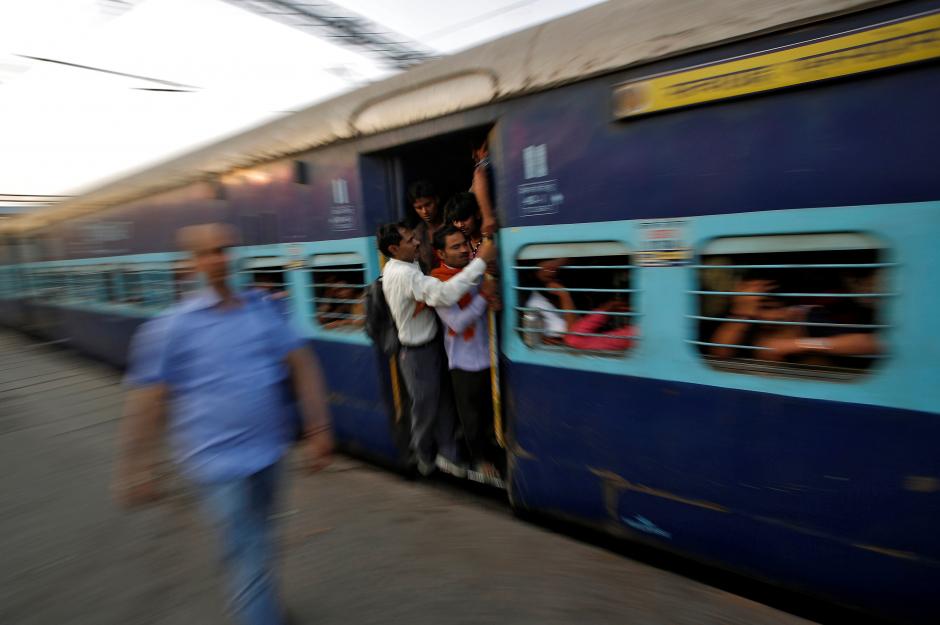With the merger of the railway budget into the general Union budget, the government has stopped putting out railway budget papers. Now, little bits of information are selectively given out, making it different to compare like for like.

Passengers board an overcrowded train at a railway station in Ajmer, India, October 23, 2016. Credit: Reuters/Himanshu Sharma/File photo

The railways are in a pretty bad way. Its operating ratio – what it spends to earn a rupee or 100 paisa – has crept up to 98.5% for the year that just went by (2017-18).
This essentially means that the state-run transporter spent Rs 98.5 to generate Rs 100. If you take away the window dressing, the truth that will emerge is that it has turned loss-making.
This is sad because the railways had always held its head high for being a rarity – a huge public utility that earned its keep. How did it get to this sorry state, how can it turn itself around and what does the longer-term future hold?
To get a sense of the organisation’s multiple ailments, look at the way the final operating ratio figure has emerged. The budget estimate for 2017-18 pegged it at 94.6%, the revised estimate bumped it up to 96% and the final likely ‘actual’ figure of 98.5% marks a traverse of almost four (3.9) percentage points. What is significant is that the previous year, 2016-17, treads a similar path. A budget estimate of 92% was revised up to 94.9% and then finally settled at 96.5%, a traverse of 4.5 percentage points.
If there is a large difference between what was estimated in the first place and the final ‘actual’ figure, then it indicates that the budgetary process has lost credibility.
A good budgetary estimate will be only marginally revised at the end of the year and the final figure will be only fractionally different from the revised estimate.
This means that either non-serious budget estimates are put out so that they look respectable and politically un-embarrassing, or senior railway officials have forgotten how to make an intelligent guess of how the year will unravel. Since there is no reason to assume that senior officials have suddenly lost their minds, it seems that politics has pushed out economics in the budget-making process for the railways.
The problem with the numbers does not end here. A recent report in Economic Times, quoting a railway board member by name, says that last year (2017-18) the railways achieved their best ever freight loading and thereby posted a Rs 10,000 crore rise in total traffic earnings over what was achieved the previous year to reach Rs 1.65 lakh crore. This implies that the figure for the previous year (2016-17) was Rs 1.55 lakh crore.
But the ‘budget at a glance’ (not publicly available) prepared with last year’s Union budget shows a revised estimate for 2016-17 of gross traffic receipts of Rs 1.72 lakh crore. If that be so, then last year’s (2017-18) gross traffic receipts actually fell by Rs 7,000 crore instead of rising by Rs 10,000 crore. Of course, ‘total traffic earnings’ and ‘gross traffic receipts’ can mean slightly different things and some accuracy can get lost in media transmission.
This brings us to the heart of the problem. With the merger of the railway budget into the general Union budget, the government has stopped putting out railway budget papers. Now, little bits of information are selectively given out, making it different to compare like for like.
As a result of this backward journey into opacity instead of a forward march into greater transparency – the declared aim of this government – you do not know what exactly is going on at any given moment and therefore are unable to come to an understanding of either the malaise or the cure needed.
The key reason attributed by the railways for the poor, worse-than-anticipated performance (operating ratio) is the outgo on implementing the award of the seventh pay commission. Plus, there has been lower-than-expected revenue from asset monetisation and PSU dividend going directly to the finance ministry as a result of the merger of the railway budget with the general budget.

Passengers travel in an overcrowded train at Ghaziabad railway station on the outskirts of New Delhi, India, April 20, 2017. Credit: Reuters/Adnan Abidi
But it is also of case of slow growth in business volumes. During the five-year period 2013-14 to 2017-18, revenue earning freight traffic grew from 1,008 million tonnes (annual report 2016-17) to 1,162 million tonnes (above news report), achieving a compound annual growth rate of 2.88%. This is over a period when the Indian economy has grown annually at roughly 7%.
These figures indicate that the railways is gradually losing market share. Plus, earnings growth cannot be protected by raising fare and freight rates significantly as that will further negatively impact market share.
To turn things around it has to pursue two strategies: One, go in for aggressive marketing to recover market share and two, cut costs.
Both these strategies take time to produce results, but cost cutting is a bit more in the railways’ own hands.
Inhuman resources
In order to cut costs, the key area to focus is staff strength and staff costs. In 2016-17, the wage bill including pensions came to a colossal Rs 1.15 lakh core when total working expenses was Rs 1.60 lakh crore. So cost on staff accounted for an incredible 72% of what the railways spent overall. Over the previous year, staff costs grew by a massive 23.6%. Not so far back, the share of staff costs to total expenses was 51.5% (2014-15 budget), indicating the impact that the pay commission recommendations have had.
The reality is that so long as the railways remain a part of the government it has to be guided by the pay commission recommendations and has no discretion in the matter of paying affordable compensation. By merging the railway budget with the general budget the railways have moved more into the government’s fold whereas if they had been corporatised, it would have been a movement in the opposite direction. This would have given the management a degree of negotiating flexibility.
Unable to have any say in fixing wage rates, the one option that the railways have over cost control is to over time cut down the total number of staff along with introduction of new technology. (The latter enhances both safety and productivity.) This is what its strategy was when it put together its ‘Vision 2020’ document that set out to reduce the staff strength (a massive 1.33 million in 2016-17) by 1% a year.
But far from reduction, the railways has kicked off a hiring process that will see it bring on board 90,000 people, an exercise which is being touted as the world’s largest recruitment drive.
This is being justified on safety grounds, with the ministry claiming that there are 1.29 lakh vacancies in “safety cadres”, whatever that might mean. (There is no ‘safety cadre’ in the railways.)
If this massive recruitment drive is carried out in an election year for which a stupendous 25 million applications have been received, then by current reckoning it could sound the financial death knell of the railways.
So if you are worried that the railways are on their way to getting into red, far worse is yet to come.
Subir Roy is a senior journalist and the author of Made in India: A study of emerging competitiveness (Tata Mcgraw Hill, 2005) and the forthcoming Ujjivan: The microfinance frontrunner (OUP).



.jpg)
.jpg)



0 comments:
Post a Comment